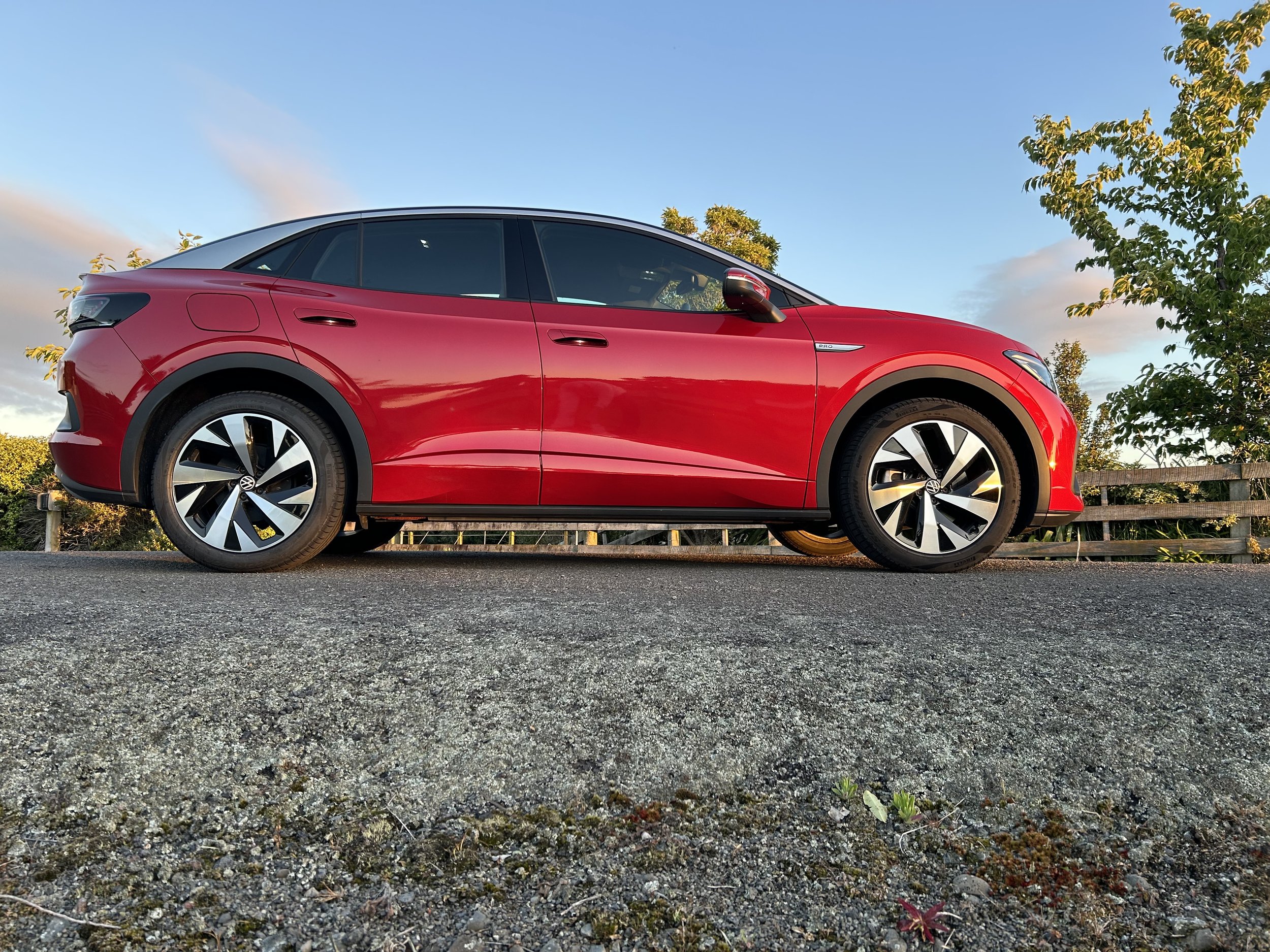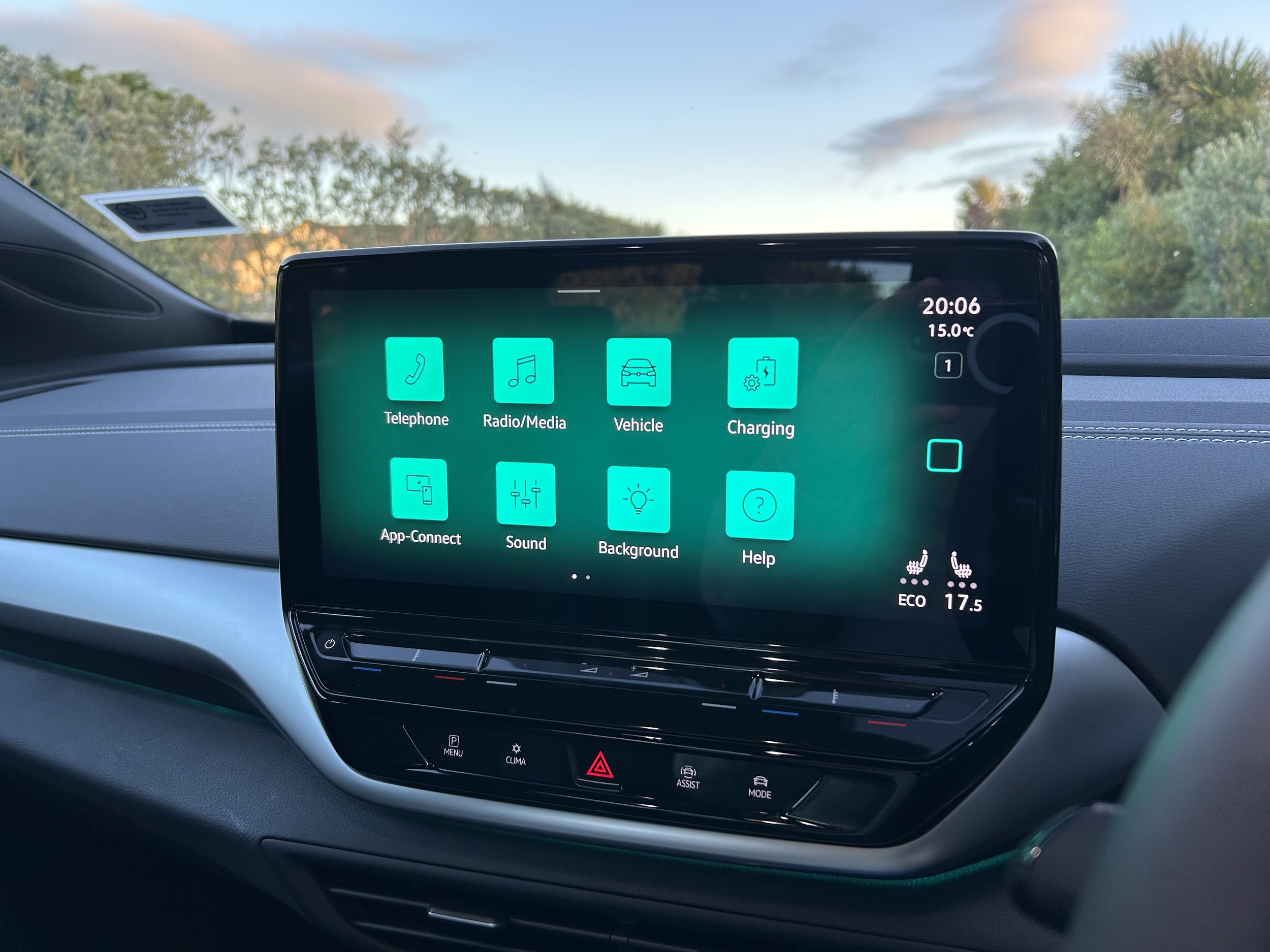VW ID.5 Pro Plus roadtest review: Sensible schmooze
/The highest-priced version packs more kit into a sharper-looking body, but overall it’s playing a straight bat.
Price: $95,490 full RRP ($88,490 on promotion).
Powertrain: Permanent magnet synchronous motor, 77kWh lithium ion battery, rear-wheel drive, maximum power 150kW, maximum torque 310Nm; single speed, rear-wheel-drive.
How big: 4599mm long, 1852mm wide, 1613mm high, 2771mm wheelbase.
SPEAK to some electric vehicle acolytes and they tell you that, if buying used, the answer is always a Leaf and, when going for new, you cannot beat a Tesla.
For sure, both cars have a firm hold in their respective categories, but surely now there’s real choice for buyers they are no longer the be-all. Assuming you accept that was ever the case?
Volkswagen will be hoping so now that their volume electrics, the ID.4 and ID.5, have finally landed.
Europe’s dominant make has invested hugely in the MEB platform that underpins not just these sister sports utilities - which differ mainly in shape, with the higher number choice having a coupe roof-line whereas the other is more blocky - but also key models from other brands within the VW family.
That the Audi (Q4/Q5), Skoda Enyaq and Cupra Born also run the same chassis, battery and electric motor; all in rear-drive form save for the most expensive Audi, which has two motors, doesn’t raise too much chance of in-family fighting, as they tend to work different sales zones, though in this instance Enyaq should be considered a competitor.
Not the only one. Ford Mustang Mach-E, the Kia EV6 and Hyundai Ioniq 5 might well be cross-shopped and, of course, there’s every chance the Tesla Model Y will be a barometer.
The latter has to be the toughest adversary. Bigger-sized, more spacious and a stronger drivetrain than anything else are practical allures. On top of that, there’s the whole thing about being seen in a Tesla. It’s first year, 2022, brought 4226 sales and last year it nailed 3936; enough in both periods to be market number one.
Because they didn’t turn up until last August, the IDs’ chance of looking like a threat begins this year. The first few months of involvement haven’t been easy. They’d barely settled in when the shenanigans ultimately leading to Clean Car’s demise kicked in. All this after the huge effort to secure them.
ID.4 having been in build since 2021 and ID.5 coming out a year later doesn’t undermine the overall quality of VW’s effort. The look is a bit straight-laced, but that’s Volkswagen, right? In driving feel and technology delivery they’re still avant garde.
Also inherent is a sense of these being products of a maker that knows what it is doing. Fans of new-age EVs tend love bagging legacy makers as being behind the eight-ball and doomed to be toppled by new entries. Seems everyone’s an industry expert the moment they plug in. They know nothing. The intricacies of car-making is far more complex. Ingrained know-how in respect to engineering, designing and manufacturing counts. VW started in 1937, though the name didn’t emerge until a year later. It’s young compared to some of the old hands, but old enough to know what it’s doing. There’s no sense of ineptitude here.
Still, consumer feedback in the places where ID has been selling for several years suggests there is room for improvement.
The ID.4 and ID.5 has a minimalist interior with a big touchscreen that controls virtually everything in the car. It’s copped a lot of flak from buyers for being annoying to use. A rejig is coming.
They’re bringing back buttons to placate those of use who dislike how the climate controls are placed within the screen. Feedback is they're not as easy to use when on the move as physical controls. Meh. I would agree that the sliding temperature and volume controls not being illuminated at night is an issue. A big one. How that got ticked off I’ll never know.
Also in for refresh is the window switch panel. At the moment you get two switches on the driver’s door as controllers for four windows. Huh? The design operate the front glass sections unless you brush a haptic bar behind; that enacts the rears instead. Honestly, I didn’t mind it.
Be aware this is a voice-control car and just saying another about ‘ID’ is enough to prompt it into trying to help you.
There’s a conventional start/stop button, but it might gather dust, as the car will also start with just the twist of the drive controller so long as you have the key in your keeping.
The variant on test is the most expensive. With a capital ‘E’. ID.5 in base form doesn’t hold premium over the blockier ID.4, but the more generously-equipped Pro Plus does.
It’s more down to kit than fit out. Even the most expensive type still has plastics that are surprisingly hard and a bit cost-saver in appearance, but overall it has a pleasing ambience. A panoramic glass roof that arrives with top spend helps the cabin to feel light and airy.
The locally-available five-seater passenger models with most impressive drag co-efficiency are all electrics, but that wasn’t really the aim with ID.5 They just wanted to please the eye.
The end result is unquestionably pleasing. Sure, it’s a car that remains clearly very much related to the alternate large hatchback. Yet it also patently less square-edged and considerably sleeker. Anything that conjures sense of individuality is good.
Design variance runs to the coupe having the largest wheels, 21s in top format, plus a slightly different front bumper, while it absents the roof rails and distinctive spoiler add-on over the rear glass found on ID.4.
Relatively small things, perhaps, but chances are, everyone who sees it will form opinion it’s more sophisticated. And, frankly, why would you want to spoil that illusion?
Having a lower roof isn’t too detrimental to interior space. Sure, it doesn’t have the great sense of space in it, front and rear, that comes with ID.4 and, obviously, rear headroom is reduced. But not cruelly; I’m 1.8 metres and a touch and can survive it.
Occupant room is larger than you'll find in many conventional crossovers. While there are ISOFIX child seat mountings in the outer two seats only, the seat base itself is notably wide, and the centre position usefully flat, so it should be possible to fit three kids in there. Occupants have access to air vents and USB sockets for convenience. The rear seat backs split and fold down and, depending on the position of the movable boot floor, a completely flat cargo area can be created.
A longer rear overhang for the ID.5 means there's a boot capacity of 549 litres, compared with 543 litres for the ID.4 in five-seat mode. The tables are turned when the back seats are folded, because the ID.4 has a 1575-litre boot to the ID.5's 1561 litres.
Driving-wise? Ultimately it’s more to do with refinement rather than outright rapidity and, again, that’s fine with me. Honestly, surely not EVERY electric has to rest its laurels on a ‘quicker than a (name your supercar)’ sprint time credential that, realistically, is totally pointless.
Buy in the VW MEB platform and, whatever the badge, you get an electric system that is tailored for sharpish, but smooth, step-off; it pleasantly piles on speed and does so with quietness. No electric whine here.
The 'sound insulated' windscreen and double glazed side windows doe seem to be extremely effective at cutting down extraneous noise. I’m not saying it’s a total cone of silence - coarse chip is coarse chip, and you can still pick up the sounds of other traffic - but it’s still quite good.
It’s not true all electrics drive the same; nor is it fair to say all MEBs are identical in their driving feel. Buy an Audi Q4/Q5 or Cupra Born and there’s sporty intent; go to the Skoda Enyaq for compliance.
The ID.5 appears to place between all those, with bump absorption with some tautness, to point its body and wheel movements are firmly controlled by the suspension, but not so much as to be ruinous to comfort. It’s all carefully-considered and not especially driver-involved. Even though using the Sport mode noticeably sharpens up responses, and the chassis has some dexterity, it’s not an outright sporty car by any means. But you won’t doubt the engineering competence, either.
VW commitment to safety features is also solid. You get an active cruise control that has a predictive feature, a lane-keep that makes itself known yet is less jerky than some and automatic emergency braking designed with errant pedestrians and cyclists in mind. Apparently, if the driver does not respond to warnings, the car can safely stop itself and turn on the hazard lights to warn other drivers. Not something I tested. Also useful at Pro level are auto dip headlights with additional cornering illumination.
Surely EVs have been around long enough now for us to accept that the WLTP range estimator is as good as those tools can be. It was carefully designed to use more real-world data to more accurately represent genuine fuel consumption that may be achieved by vehicle owners.
At same token, it’s just a guideline and, realistically, is only so accurate for any kind of powertrain because of all the variables at play.
I wouldn’t outright describe the ID.5’s cited optimal as always out of reach, but would suggest it would also require extraordinary assiduousness.
The tester ran 400kms’ easily, over a mix of surfaces and speeds, with preference for running in eco mode and making the most of regenerative braking, which activates off the drive selector toggle and also explains why it has drum rear brakes.
If that’s indicative of actual real world range I’d be happy enough, not least if home recharging is part of the picture. As it will surely be for most. One nice thing with this car is that it has a good portable trickle charger provisioned with a generous cable length. Plus you get a type two to type two cable for AC public charging. Both store neatly.
The battery pack can be charged at up to 11kW at home and, conceivably, at up to 125kW on a DC fast charger, which is a bit modest by today’s standard. A reminder that this car, though new to NZ, has been around since 2020. I also say conceivably because this car seemed most happy on 50kW chargers. I tried it on a 300kW unit and it rebelled. Could have been the car. Could have been me. Could have been the charger.
More ID models are coming. In a few years from now, these will seem less extrovert and will be accepted as they were proposed. As sensible, effective transport that works efficiently, from a brand that doesn’t feel compelled to include fart sounds to raise attention.






















